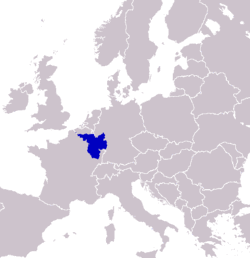
Rhineland-Palatinate is a western state of Germany. It covers 19,846 km2 (7,663 sq mi) and has about 4.05 million residents. It is the ninth largest and sixth most populous of the sixteen states. Mainz is the capital and largest city. Other cities are Ludwigshafen am Rhein, Koblenz, Trier, Kaiserslautern and Worms. It is bordered by North Rhine-Westphalia, Saarland, Baden-Württemberg and Hesse and by the countries France, Luxembourg and Belgium.

The Saarland is a state of Germany in the west of the country. With an area of 2,570 km2 (990 sq mi) and population of 995,600 in 2015, it is the smallest German state in area apart from the city-states of Berlin, Bremen, and also Hamburg, and the smallest in population apart from Bremen. Saarbrücken is the state capital and largest city; other cities include Neunkirchen and Saarlouis. Saarland is mainly surrounded by the department of Moselle in France to the west and south and the neighboring state of Rhineland-Palatinate in Germany to the north and east; it also shares a small border about 8 kilometres long with the canton of Remich in Luxembourg to the northwest.

Trier, formerly known in English as Trèves and Triers, is a city on the banks of the Moselle in Germany. It lies in a valley between low vine-covered hills of red sandstone in the west of the state of Rhineland-Palatinate, near the border with Luxembourg and within the important Moselle wine region.
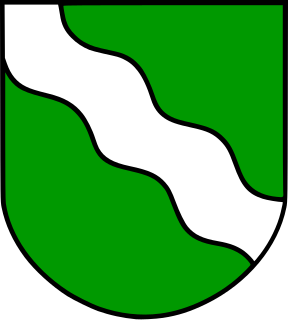
The Rhineland is the name used for a loosely defined area of Western Germany along the Rhine, chiefly its middle section.

The Moselle is a river that rises in the Vosges mountains and flows from western Germany through Luxembourg,and north-eastern France. It is a left bank tributary of the Rhine, which it joins at Koblenz. A small part of Belgium is in its basin as it includes the Sauer and the Our.

Trier was one of the three Regierungsbezirke of Rhineland-Palatinate, Germany, located in the west of the state.
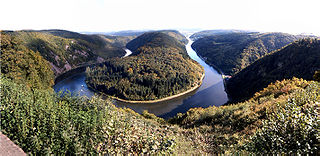
The Saar is a river in northeastern France and western Germany, and a right tributary of the Moselle. It rises in the Vosges mountains on the border of Alsace and Lorraine and flows northwards into the Moselle near Trier. It has two headstreams, that both start near Mont Donon, the highest peak of the northern Vosges. After 246 kilometres (153 mi) the Saar flows into the Moselle at Konz (Rhineland-Palatinate) between Trier and the Luxembourg border. It has a catchment area of 7,431 square kilometres (2,869 sq mi).
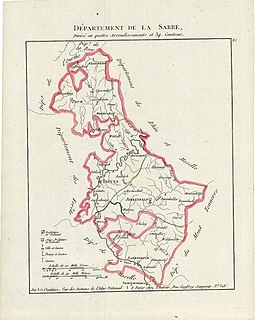
Sarre was a department in the First French Republic and First French Empire. Its territory is now part of Germany and Belgium. Named after the river Saar, it was created in 1798 in the aftermath of the Treaty of Campo Formio of 18 October 1797 which ceded the left bank of the Rhine to France.
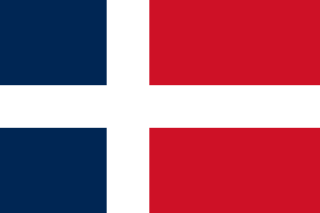
The Saar Protectorate officially Saarland was a short-lived protectorate (1946–1957) partitioned from Germany after its defeat in World War II. It was administered by the French Fourth Republic. On rejoining the Federal Republic of Germany in 1957, it became the smallest "federal state" (Bundesland), the Saarland, not counting the "city states" of West Berlin, Hamburg, and Bremen. It is named after the Saar River.

Moselle Franconian is a West Central German language, part of the Central Franconian language area, that includes Luxembourgish. It is spoken in the southern Rhineland and along the course of the Moselle, in the Siegerland of North Rhine-Westphalia, throughout western Rhineland-Palatinate and Saarland, Luxembourg, the south of the German-speaking Community of Belgium and in the neighboring French département of Moselle. The Transylvanian Saxon dialect spoken in the Transylvania region of Romania is derived from this dialect as a result of the emigration of numerous "Transylvanian Saxons" between 1100 and 1300, primarily from areas in which the Moselle Franconian dialect was then spoken.
Greater Region is the area of Saarland, Lorraine, Luxembourg, Rhineland-Palatinate, Wallonia and the rest of the French Community of Belgium, and the German-speaking Community of Belgium. It is not identical with the SaarLorLux Euroregion, despite being in the same territory.

The Roscheider Hof Open Air Museum is the open-air museum and Folklore Museum of the Greater SaarLorLux Region. The museum is situated in Konz, Germany, on the Saar and Mosel rivers, 8 km west of Trier and 30 km east of Luxembourg. It is a museum for rural cultural history in northwest Rhineland-Palatinate and the German-Luxembourg-Lorraine border region. Unlike many other open-air museums, the Roscheider Hof is not a public or community institution. The sponsoring organisation for the museum since its foundation has been the registered, non-profit association founded in 1973, "Volkskunde- und Freilichtmuseum Roscheider Hof, Konz e.V." with over 1000 members in 2007. The museum is financed by membership fees, entrance charges, subsidies and donations. The founder of the association was Prof. Rolf Robischon.
The Grande Région (French) or Großregion (German) programme lies within the Interreg IV A programme of the European Union's European Regional Development Fund. It facilitates cooperation between project partners from the different parts of the Greater Region of Luxembourg: Luxembourg, the Belgian provinces of Luxembourg and Liège, the French Lorraine region as well as the Saarland and large parts of Rhineland-Palatinate. The programme covers the period 2007-2013. Projects approved within the programme receive financial aid of up to 50% of their budget.

The Greater Region of Luxembourg, or simply Greater Region, is a geopolitical region within Europe, created to promote economic, cultural, touristic and social development and cooperation. It occupies an area of 65,401 square kilometres (25,251 sq mi) with Luxembourg at its center and including adjacent regions of Belgium, Germany and France.

The Koblenz–Trier Railway is a railway line in the German state of Rhineland-Palatinate, located mostly on the left (northern) bank of the Moselle, connecting Koblenz via Bullay to Trier. It is known in German as the Moselstrecke, i.e. "Moselle line". It is often called the Moselbahn links der Mosel to distinguish it from the Moselle Railway (Moselbahn) or Moselle Valley Railway (Moseltalbahn), which ran on the right (southern) bank of the Moselle from Bullay to Trier, but was abandoned in the 1960s. The line was built as part of the Cannons Railway (Kanonenbahn) and opened in 1879.

The Saarbrücken–Trier railway, known in German as the Saarstrecke in the German states of Rhineland-Palatinate and Saarland. It connects Saarbrücken and Trier. It was opened in 1858 and 1860 and is one of the oldest railways in Germany.

The Thionville–Trier railway connects Thionville in the French region of Grand Est with Trier in the German state of Rhineland-Palatinate. It also passes through the westernmost part of the Saarland along the Moselle for a few kilometres.

The Saargau was a Frankish Gau county (Gaugrafschaft). Today the name is given to the ridge between the rivers Saar and Moselle in Germany and, in the south, the region between the Saar and the French border.

The Upper Moselle is the name given in Germany to that section of the River Moselle, 45 kilometres long, that runs from the Franco-German-Luxembourg tripoint near Perl to its confluence with the Saar near Konz shortly before Trier. From the tripoint to its confluence with the Sauer, the Upper Moselle forms the border between the German states of the Saarland and Rhineland-Palatinate on the one side and Luxembourg on the other. This stretch of the river known as the Upper Moselle is, however, not the same as the geographical upper reaches of the Moselle, which run from its source near Bussang in the Vosges mountains in Lorraine via Épinal and Nancy roughly as far as Metz.

The Friendship Bridge is a bridge which crosses the Saar river, south of Saarbrücken, and links the Saarland municipality of Kleinblittersdorf with the Lorraine commune of Grosbliederstroff.
